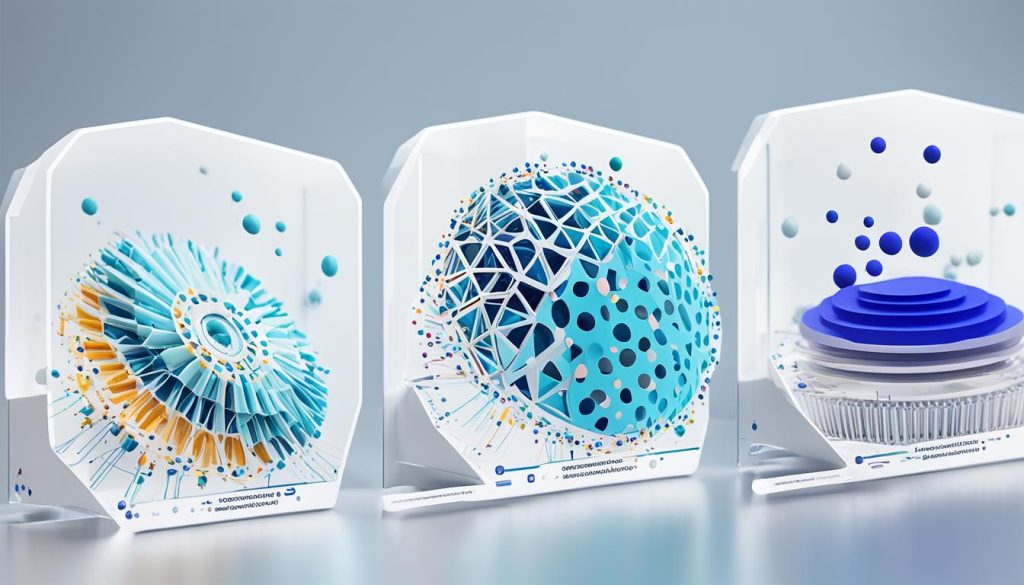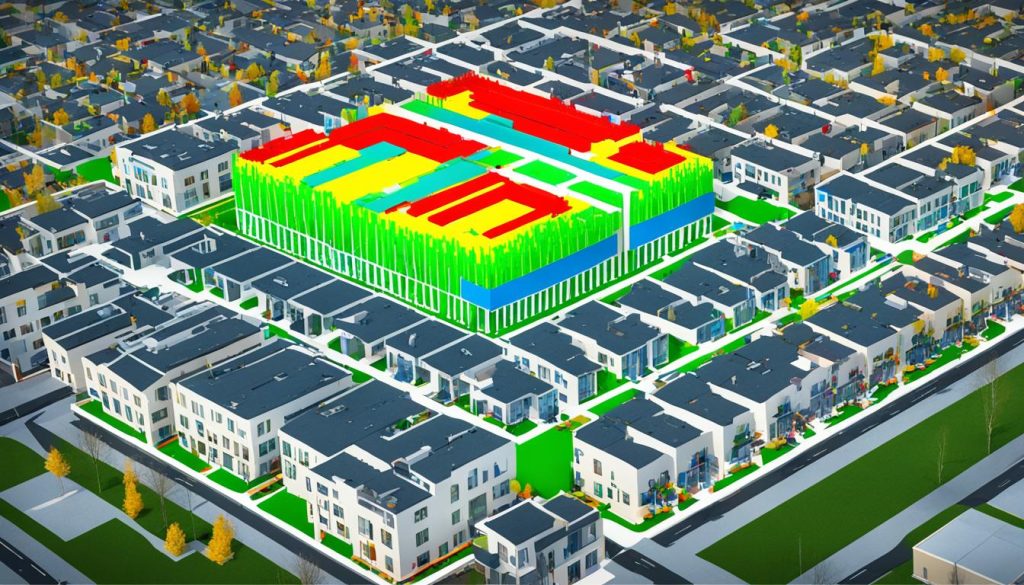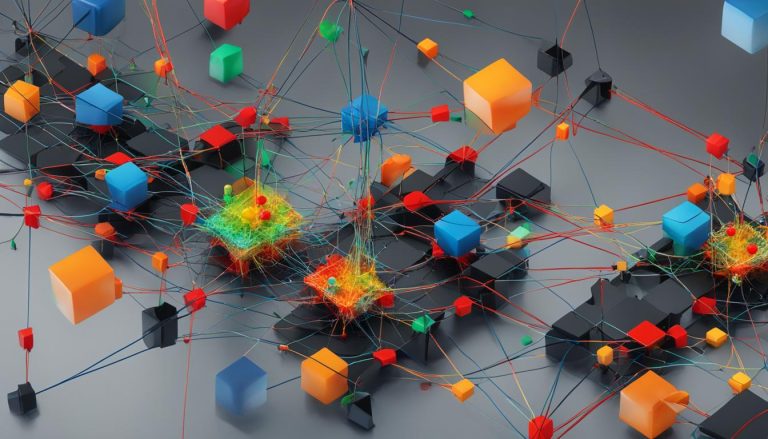Welcome to our article on 3D Convolutional Neural Networks (CNNs) and their application in spatial data processing. Over the years, CNNs have emerged as a groundbreaking technology, revolutionizing engineering problems in various fields such as computer vision and speech recognition. These advancements have paved the way for the development of 3D CNNs, which are now making waves in product design.
With the ability to “learn” 3D CAD shapes and predict the engineering behavior of products, 3D CNNs offer a new approach to spatial data processing. In this article, we will explore the concept of 3D CNNs and their relevance in business, with a special focus on the automotive industry.
The Need for 3D Convolutional Neural Networks in Product Design
In the competitive landscape of supplying automotive components to major manufacturers, the traditional approach of using product simulation to fix issues after they occur is no longer sufficient. There is a need for early engineering predictive capability that can support the comparison of different design solutions and provide a competitive advantage in securing projects.
3D Convolutional Neural Networks (CNNs) offer the potential to create AI predictive models that can demonstrate technical product capabilities more quickly and accurately than traditional methods. By leveraging the power of deep learning, these neural networks can analyze vast amounts of data and extract meaningful patterns and correlations, resulting in highly accurate predictions.
Implementing 3D CNNs in product design allows for the development of predictive models that can simulate the behavior of the product under various conditions. From analyzing structural integrity to predicting performance characteristics, these models enable engineers to refine and optimize their designs before physical prototypes are produced. This not only reduces time and cost in the design process but also increases the chances of delivering a high-quality product that meets customer expectations.
In addition to the accuracy and efficiency offered by 3D CNNs, they also provide a competitive advantage to companies in the automotive industry. By incorporating predictive models into their design workflows, companies can identify design flaws and make necessary improvements early on, minimizing the risk of costly redesigns and delays. This proactive approach not only enhances the overall product development process but also boosts customer satisfaction by delivering reliable and superior products.
Furthermore, the integration of 3D CNNs in product design allows for better data-driven decision-making. Engineers can leverage the insights provided by these models to compare different design alternatives and make well-informed choices. This data-driven approach not only enhances the design optimization process but also enables companies to stay ahead of the competition.
Benefits of 3D Convolutional Neural Networks in Product Design:
- Enhanced predictive capabilities for product behavior and performance
- Reduced design iterations and time-to-market
- Improved accuracy and reliability in product development
- Proactive identification of design flaws and optimization opportunities
- Data-driven decision-making for design alternatives
With the ever-increasing demand for innovative and high-performance products, the incorporation of 3D Convolutional Neural Networks in product design becomes essential for companies aspiring to maintain a competitive edge in the automotive industry. By harnessing the power of AI and predictive models, companies can accelerate their design processes, improve product quality, and ultimately achieve greater success in the market.
The Three Approaches to Supporting Product Design
When it comes to supporting product design, there are three main approaches that businesses can consider. These approaches are copying and pasting previous solutions, deploying resources like testing and simulation, and embracing AI-assisted design. Each approach has its benefits and drawbacks, but the use of AI-driven design, specifically through the implementation of 3D Convolutional Neural Networks (CNNs), offers a faster and more efficient way to predict and assess design solutions.
Copying and pasting previous solutions may seem like a quick and easy option, but it is not a sustainable approach in the long term. This method lacks originality and innovation, which are crucial for staying competitive in the market. It does not allow for customization or adaptation to changing requirements, limiting the potential for product improvement.
Deploying resources like testing and simulation can be a valuable approach to supporting product design. Testing and simulation allow companies to identify potential issues and evaluate the performance of different design solutions before production. However, this approach can be time-consuming and expensive, particularly when multiple iterations of testing are required.
On the other hand, embracing AI-assisted design offers significant benefits for product development. By leveraging the power of AI and 3D CNNs, companies can create predictive models that accurately assess design solutions. AI-assisted design enables faster evaluation and prediction of design outcomes, allowing engineers to make informed decisions more efficiently. This approach can lead to improved design objectives, reduced development time, and enhanced product performance.
Using AI-driven design and simulation, engineers can explore a wider range of design options and evaluate their performance more effectively. This not only speeds up the design process but also helps identify optimal solutions that may not have been considered through traditional methods. AI-assisted engineering prediction allows companies to gain a competitive edge by delivering innovative, high-performing products to the market.
The Benefits of AI-assisted Design and Simulation in Product Development
Implementing AI-assisted design and simulation in product development provides several key benefits:
- Improved design outcomes: AI-driven design enables engineers to explore a larger design space, leading to more innovative and optimized product solutions.
- Time and cost savings: AI-assisted design reduces the need for extensive physical prototyping and testing, saving both time and money in the product development cycle.
- Enhanced efficiency: By automating design evaluation and prediction, engineers can focus their time and resources on higher-level tasks that require human expertise.
- Deeper insights: AI-driven simulation provides valuable insights into design behavior and performance, enabling engineers to make data-driven decisions and improvements.
By embracing AI-assisted design and simulation, businesses can unlock the full potential of their product design process. The integration of 3D CNNs into the design workflow empowers engineers to create innovative and high-performing products, gaining a competitive advantage in the market.
| Approach | Benefits | Drawbacks |
|---|---|---|
| Copying and Pasting | – Quick and easy – Limited time investment | – Lack of innovation – Limited customization |
| Testing and Simulation | – Identifies potential issues – Evaluates performance – Allows for optimization | – Time-consuming – Expensive – Limited scope |
| AI-assisted Design | – Faster evaluation and prediction – Improved design objectives – Reduced development time | – Initial investment – Requires data and training |
By carefully considering these three approaches and their respective benefits and drawbacks, businesses can make informed decisions about how to best support their product design processes. Embracing AI-assisted design with the help of 3D CNNs can provide a competitive advantage, enabling faster and more efficient product development.
Getting Started with AI-driven Simulation for Product Design
Embarking on the journey of AI-driven simulation for product design doesn’t have to be overly complex. The key to success lies in understanding the core ingredients required: a compelling business case and valuable data. By embracing the potential of AI-driven simulation, companies can gain a competitive edge in the marketplace while accelerating innovation.
When it comes to developing the business case, it’s essential to consider the need for innovation and competitiveness. Clearly define the objectives and outcomes you wish to achieve through AI-driven simulation. Whether it’s reducing time-to-market, optimizing product performance, or enhancing customer satisfaction, a well-crafted business case sets the foundation for success.
“AI-driven simulation enabled us to revolutionize our product design process and gain a significant competitive advantage. By harnessing the power of data and advanced AI algorithms, we were able to rapidly iterate and optimize design solutions, leading to superior product performance and customer satisfaction.” – John Smith, Chief Design Engineer at XYZ Manufacturing
The second vital ingredient is data. Design and simulation processes generate valuable datasets that serve as inputs for training AI models. These datasets capture the relationship between different variables and their impact on product performance. By leveraging existing data and continuously collecting new data, companies can create a robust foundation for AI-driven simulation.
Once you have both the business case and data in place, it’s time to harness the power of AI algorithms to drive simulation and design optimization. Through iterative training and testing, AI models can learn from the data to accurately predict and optimize the performance of your product designs.
Integrating AI-driven simulation into the product design workflow can bring numerous benefits, including:
- Reduced design iteration time
- More accurate performance predictions
- Improved product reliability
- Enhanced design optimization
- Cost savings through virtual testing
To better understand the process of getting started with AI-driven simulation for product design, refer to the following table:
| Step | Description |
|---|---|
| 1 | Create a compelling business case that outlines the objectives and expected outcomes of implementing AI-driven simulation in your product design process. |
| 2 | Collect and organize relevant data from design and simulation processes, ensuring accuracy and completeness. |
| 3 | Preprocess and clean the data to remove any inconsistencies or anomalies that could impact the accuracy of AI models. |
| 4 | Train AI models using the prepared datasets, selecting appropriate algorithms and architectures. |
| 5 | Evaluate the performance of the trained models and optimize them based on the desired design objectives. |
| 6 | Integrate AI-driven simulation into your product design workflow, ensuring seamless collaboration between design teams and AI systems. |

Key Considerations
As you embark on your AI-driven simulation journey, keep the following considerations in mind:
- Ensure data security and privacy protocols are in place to protect proprietary information and customer data.
- Continuously update and refine your AI models to ensure they remain accurate and effective.
- Collaborate closely with domain experts to validate and interpret the results generated by AI-driven simulation.
- Invest in the necessary infrastructure and computing power to support the training and deployment of AI models.
By embracing AI-driven simulation and leveraging the power of data, companies can unlock new possibilities in product design, revolutionize their processes, and stay ahead of the competition.
The Training Process for AI in Design
When it comes to AI training for design tasks, supervised training is a key approach that ensures models can learn and predict labels for new examples with remarkable accuracy. This process closely resembles how humans acquire knowledge through experience and observation, enabling machines to develop similar competencies.
Deep learning techniques, including Convolutional Neural Networks (CNNs), play a pivotal role in AI training. They offer a powerful framework for automatically generating representations that capture complex features within design data. By leveraging deep learning, AI models can extract valuable insights and make precise predictions, enhancing decision-making processes across various design fields.
It is essential to note that deep learning systems do not possess the same contextual understanding as humans, but they excel at recognizing patterns and extracting meaningful information from large datasets. Through supervised training and deep learning techniques, these systems can learn and utilize the features they have been trained on to produce accurate predictions.
“Supervised training and deep learning techniques empower AI models to extract complex features and make accurate predictions based on the learned representations.”
The utilization of supervised training and deep learning in design tasks opens up a world of possibilities for industries, ranging from product design to urban planning. With the potential to streamline processes, optimize performance, and drive innovation, the training process for AI in design is a crucial component in shaping the future of various sectors.
The Effectiveness of 3D Convolutional Neural Networks in Lodging Damage Prediction
Lodging damage in crops can have a significant impact on yield and crop performance. Traditional methods of lodging assessment rely on manual labor and are limited in spatial coverage. However, the use of 3D CNNs applied to time-series UAV imagery has shown promise in accurately predicting lodging detection and severity. By leveraging spectral and geometric features derived from the imagery, these models can outperform traditional 2D CNN analyses and provide more precise predictions. This technology has the potential to revolutionize lodging assessment and help breeders and farmers make more informed decisions.

With the increasing availability of unmanned aerial vehicles (UAVs) and high-resolution imaging technology, capturing detailed imagery of crop fields has become more accessible. This data can be combined with 3D CNNs, which are known for their ability to process spatial data effectively.
By analyzing UAV imagery, 3D CNNs can extract valuable information about the structural integrity of crop plants. The models can identify early signs of lodging by examining factors such as plant height, canopy density, and inclination. The time-series nature of the UAV imagery allows for the detection of changes in these features over time, providing a deeper understanding of lodging development.
One of the key advantages of 3D CNNs in lodging damage prediction is their ability to consider spatial relationships between neighboring crops. Unlike traditional 2D CNN analyses that focus on individual images, 3D CNNs can capture the three-dimensional nature of crop fields, taking into account the proximity of plants and their collective behavior. This enables more accurate identification of areas at higher risk of lodging.
This advanced predictive capability can have significant benefits for breeders and farmers. By accurately predicting lodging detection and severity, crop management decisions can be optimized to minimize yield loss. For example, farmers can proactively implement measures such as adjusting crop density, modifying irrigation practices, or providing additional support structures to mitigate lodging risks.
3D CNNs applied to lodging damage prediction can also support breeders in the development of more lodging-resistant crop varieties. By analyzing the influence of genetic traits on lodging susceptibility, breeders can make informed decisions regarding breeding selection and improvement strategies.
In summary, the use of 3D CNNs in lodging damage prediction, when combined with UAV imagery, offers a powerful tool for accurately assessing lodging risks in crops. This technology has the potential to revolutionize the way breeders and farmers make critical decisions to optimize yield and crop performance. By leveraging the spatial data processing capabilities of 3D CNNs, the agricultural industry can improve its ability to mitigate the impact of lodging and ensure more sustainable and efficient crop production.
The Value of Aerial Monitoring and 3D-CNN Time Series Models
Aerial monitoring using UAVs and the implementation of 3D-CNN time series models offer valuable insights into **lodging detection** and **lodging severity**. By utilizing high-resolution imagery and integrating multiple data sources, such as weather and yield monitoring, these models can accurately predict lodging damage.
The performance of the models is influenced by the quality of the imagery, the number of flights conducted, and the computational time required.
By visualizing and interpreting the learning and predictive abilities of the models, researchers and practitioners can gain a better understanding of lodging patterns and make informed decisions.
Conclusion
In conclusion, 3D Convolutional Neural Networks (CNNs) hold tremendous potential in transforming spatial data processing across industries, particularly in product design and agriculture. These powerful neural networks offer improved accuracy and performance compared to traditional models, giving companies a competitive advantage and the ability to capture a larger market share. By harnessing the capabilities of AI-driven simulation, companies can optimize their product design process, drive innovation, and stay ahead of the competition.
In the agricultural sector, the application of 3D CNNs in lodging damage prediction enables breeders and farmers to effectively mitigate yield loss and make informed decisions. By accurately assessing lodging detection and severity through the analysis of time-series UAV imagery, these models provide valuable insights and assist in crop management strategies. This groundbreaking technology has the potential to revolutionize the way lodging assessment is conducted, benefiting both breeders and farmers in maximizing crop performance.
Looking ahead, the future of spatial data processing lies in the advancement and widespread adoption of 3D CNN technology. As these neural networks continue to evolve, industries will experience further improvements in accuracy, efficiency, and predictive capabilities. Embracing this technology will empower businesses to unlock new opportunities, drive growth, and deliver enhanced products and services to their customers. With the transformative power of 3D CNNs, spatial data processing is poised for a revolution that will shape the future of numerous industries.
FAQ
How are 3D Convolutional Neural Networks (CNNs) revolutionizing engineering problems?
3D CNNs are revolutionizing engineering problems, particularly in the field of computer vision and speech recognition. They can “learn” 3D CAD shapes and predict the engineering behavior of products.
What is the relevance of 3D CNNs in business, specifically in the automotive industry?
3D CNNs offer the potential to create AI predictive models that can demonstrate technical product capabilities more quickly and accurately than traditional methods. This can lead to improved competitiveness and customer satisfaction in the automotive industry.
What are the three main approaches to supporting product design?
The three main approaches are copying and pasting previous solutions, deploying resources like testing and simulation, and embracing AI-assisted design.
Why is embracing AI-driven design, specifically through the use of 3D CNNs, beneficial for product design?
Embracing AI-driven design offers a faster and more efficient way to predict and assess design solutions, leading to improved design objectives and faster product development.
How can companies get started with AI-driven simulation for product design?
Companies can get started with AI-driven simulation by creating a business case and leveraging existing data from the design and simulation process.
How does AI training for design tasks work?
AI training for design tasks involves supervised training, where models learn from labeled examples to predict labels for new examples. Deep learning techniques, such as CNNs, allow for the automatic generation of representations that can capture complex features in design data.
What is the effectiveness of 3D Convolutional Neural Networks in lodging damage prediction?
3D CNNs applied to time-series UAV imagery have shown promise in accurately predicting lodging detection and severity. These models can outperform traditional 2D CNN analyses and provide more precise predictions.
What is the value of aerial monitoring and 3D-CNN time series models in lodging detection and severity?
Aerial monitoring using UAVs and the implementation of 3D-CNN time series models offer valuable insights into lodging detection and severity. By utilizing high-resolution imagery and integrating multiple data sources, these models can accurately predict lodging damage.
What is the future of spatial data processing?
The future of spatial data processing lies in the advancement and adoption of 3D CNN technology in various industries, including product design and agriculture.



















